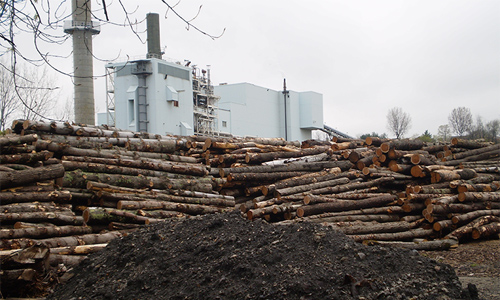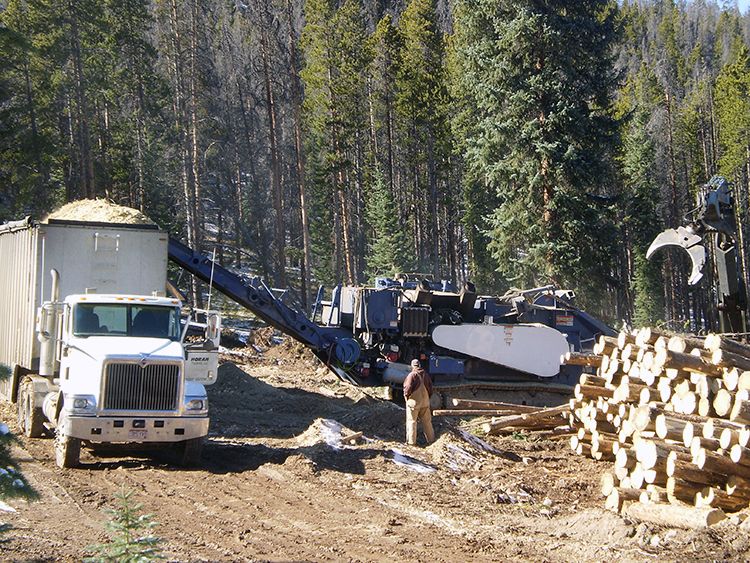

By Josh Schlossberg
A report funded by Clean Air Council questions whether biomass should count as renewable energy, arguing that carbon dioxide and air pollutant emissions disqualify the controversial energy source.
Wood Burning, Biomass, Air Pollution and Climate Change, by Christopher D. Ahlers, adjunct professor of Law at Vermont Law School, explains that the term renewable is a “subjective policy judgment” that must take into account the health and environmental impacts of a given energy source.
Currently, biomass energy makes up 50 percent of renewable energy in the U.S., according to the U.S. Energy Information Administration, with half of that tally coming from wood products.
Ahlers, legal support for the Philadelphia-based Clean Air Council, contrasts biomass energy from solar and wind and instead compares bioenergy to fossil fuels, as “both involve the extraction of solid material from the Earth, for the purpose of combustion.” He also discusses the time difference between growing a new tree (decades to centuries) and the formation of new fossil fuel deposits (millennia).
The Carbon Question
The idea of separately accounting for the carbon emissions of fossil fuels and bioenergy—biogenic carbon—is “ambiguous,” according to the report, which references the U.S. Environmental Protection Agency’s (EPA) ongoing “uncertainty” on the topic.
While wood gradually emits carbon dioxide as it decomposes in the forest, Ahlers points out that wood burned in a biomass facility releases the CO2 in one immediate pulse. Still, he notes the issue involves a “complex factual question” that climate scientists have “wrestled with.”
Biomass101, a coalition of organizations representing the forest products industry, agrees that accounting for bioenergy carbon emissions is complicated. In an email to The Biomass Monitor, a representative writes that biomass energy is “part of a complex process of carbon capture, storage and emission that carries on much the same whether trees become forest bioenergy or are lost to insects, disease, storm damage, wildfires and the like.”
The organization contends that “biomass is carbon neutral where American forests are capturing as much or more carbon as energy production is emitting and where sustainable forest management is reinforcing that dynamic.”
When it comes to directly measurable smokestack emissions, Ahlers writes that biomass energy generates “nearly as many carbon dioxide emissions as coal and significantly more carbon dioxide emissions than natural gas.”
Specifically, the EPA attributes 208.6 MMT (million metric tons) of carbon dioxide emissions per year to the commercial, industrial and residential burning of woody biomass. 120.2 MMT comes from the industrial sector, 59.8 MMT from residential burning, 21.3 MMT from the electricity sector and 7.2 MMT from commercial biomass.
Public Health
The EPA and proponents of biomass energy have distracted attention away from its public health impacts by “framing the issue of biomass around climate,” writes report author Christopher Ahlers, in an email exchange with The Biomass Monitor. Ignoring air pollution, he said, has resulted in “limiting the engagement of environmental groups,” many of which are either tangentially involved with the issue or not at all.
The report delves into the air pollution concerns from the combustion of biomass, citing World Health Organization estimates of 7 million annual deaths worldwide attributed to air pollution.
All forms of combustion, including biomass, emit nitrogen oxides and fine particulates, along with hazardous air pollutants (formaldehyde, benzene, toluene), mercury and other chemicals. The EPA has linked nitrogen oxides to respiratory problems and when it comes to particulate matter, the agency has “not identified a threshold below which there are no adverse effects on human health.”
Therefore, the report concludes that biomass energy “contributes to the formation of the country’s two most significant air pollution problems.”
Because of its air emissions, biomass is “more similar to coal, oil and natural gas (non- renewable energy), than it is to wind and solar power.”Ahlers determines that “many people have erroneously become fixated on biomass, even though it presents harm to public health.”
Culture of Wood Burning
The report also tackles the issue of residential wood burning, including wood stoves and fireplaces.
New England is a hot bed of wood heating, with Vermont, New Hampshire and Maine ranked first, fourth, fifth in per capita air emissions from wood burning. The report notes a “broader pattern of elevated asthma levels” in these states.
Ahlers compares emissions from fireplaces and woodstoves, calculating that fireplaces release twenty times the amount of particulates as an EPA-certified woodstove. An EPA-certified woodstove, meanwhile, emits 169 times more particulates than a gas furnace.
Because of what he calls a “cultural affinity for wood burning,” when it comes to wood stoves, some states are “refusing to enforce more stringent standards for the protection of public health.”
Outside of the U.S., burning wood and biomass for cooking and heating is responsible for “millions of annual deaths from household air pollution in developing countries.”
Renewable or Not?
According to Biomass101, the fact that trees cut for bioenergy eventually grow back means the energy source is “inherently renewable.”
However, Clean Air Council believes the expansion of biomass energy is less a science-based decision and more the “result of political and cultural choices being made by both consumers and corporations.”
Ahlers makes the point that nuclear energy could theoretically be considered renewable, because of its lack of direct air emissions and the fact that uranium isn’t a fossil fuel, however it’s been denied the label mostly because of its health and environmental impacts.
The report concludes that the same restrictions applied to nuclear power should be applied to biomass energy, “due to the health and environmental impacts in the form of fine particulates and harvesting of trees.”
Josh Schlossberg is the editor-in-chief of The Biomass Monitor.
YOU MIGHT ALSO LIKE
Tens of Thousands Take Part in Global Actions Targeting World’s Most Dangerous Fossil Fuel Projects
Shell Oil Spill Dumps Nearly 90,000 Gallons of Crude Into Gulf

 233k
233k  41k
41k  Subscribe
Subscribe 


